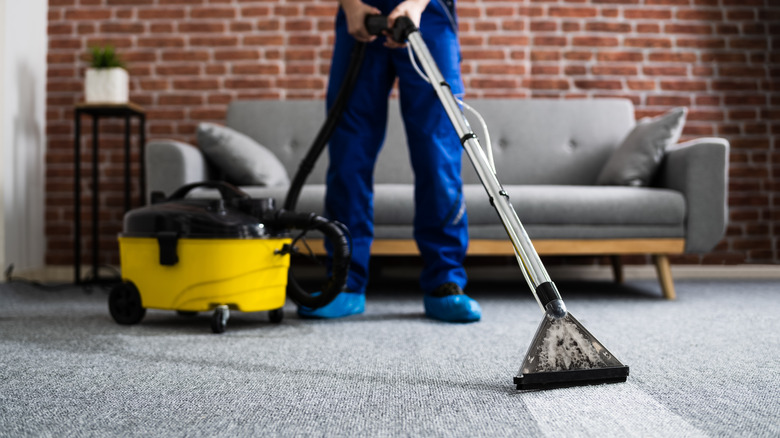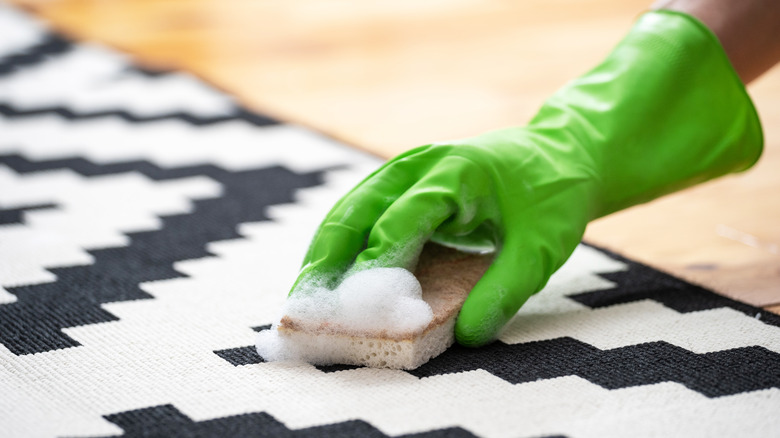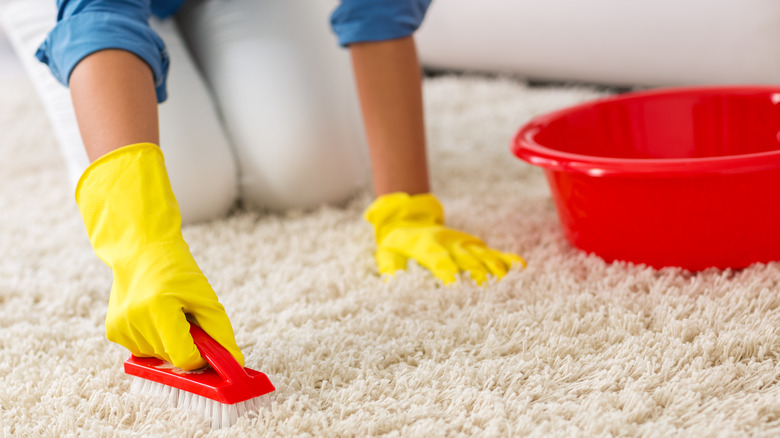Reverse This Major Carpet Cleaning Mistake With The Help Of Vinegar
Part of maintaining a home is regularly cleaning its interior. Shampooing a rug is one of those chores that nobody looks forward to, yet it's crucial for maintaining a healthy indoor environment. Over time, carpets accumulate dirt, allergens, and stains that regular vacuuming alone may not eliminate. Shampooing helps deep-clean and remove embedded pollutants, contributing to improved indoor air quality. It also prevents the growth of mold and bacteria that can thrive in dirty carpets. Ideally, carpets should be shampooed every 12 to 18 months, depending on factors like foot traffic and household activities. A clean carpet not only enhances the aesthetic appeal of a space but also extends the carpet's lifespan. Regular shampooing is an investment in both cleanliness and longevity. Nevertheless, deep cleaning a carpet can sometimes yield mixed results, especially for those unfamiliar with the process. If you find your carpet is sticky with extra shampoo afterward, it may be time to grab some vinegar to alleviate the issue.
Excess shampoo residue is a common mistake after cleaning a carpet, whether it's due to inadequate rinsing or improper dilution of the cleaning solution. It's important to remove this residue promptly as it may attract and trap dirt, causing rapid re-soiling. Moreover, it can create an unappealing texture and appearance on the carpet surface. Therefore, it's a good idea to try this vinegar method to leave your carpet clean and fresh rather than dirtier than it was to begin with, rendering all of your hard work useless.
How to remove excess shampoo with vinegar
To effectively remove sticky residue from any excess carpet shampoo after attempting to clean your carpet, all you will need is a bottle of white vinegar and a few clean and dry towels or clothing scraps. Using this method, vinegar can be a valuable and natural solution as opposed to adding additional chemicals to your carpet. Begin by soaking up any excess moisture in the carpet first using a dry towel. Dab at the wet spots to dry them before adding the vinegar. Once the carpet has been dried, wet a clean cloth with white vinegar. This will serve as a mild yet potent cleaning agent that won't harm the carpet fibers. Continue the cleaning process by blotting the affected area with the vinegar cloth. Avoid rubbing, as it may spread the residue further. Apply this method to all sticky areas, allowing the solution to penetrate the residue.
Allow the vinegar mixture to sit on the sticky residue for a few minutes. This waiting time enables the vinegar to neutralize the adhesive properties of the shampoo residue. Afterward, use a clean, dry cloth to blot and absorb the loosened residue. Repeat the process as necessary until the stickiness subsides. Once the residue is successfully removed, blot the carpet with a cloth moistened with plain water to ensure that no vinegar residue remains. Finally, blot the rinsed area with a dry cloth to absorb excess moisture.
To vinegar or not to vinegar
Vinegar serves as an excellent and affordable tool for removing excess shampoo from a carpet due to its natural cleaning properties. Its acidic nature helps break down and dissolve the sticky residues left by shampoo, facilitating easier removal. This method not only aids in loosening the residue but also neutralizes alkaline components present in some shampoos. As a result, vinegar not only cleans but also leaves the carpet pH-balanced. The natural antibacterial properties contribute to a healthier environment by inhibiting the growth of mold and bacteria. Also noteworthy, vinegar is both natural and eco-friendly, making it a safe product to use in your home for both your family and your pets.
While vinegar is generally safe for many carpets, it may not be suitable for certain types of rugs, especially those made of natural fibers like wool or silk. The acidic nature of vinegar can potentially damage these delicate fibers, causing discoloration or texture alterations. Additionally, using vinegar on carpets with dyes that are not colorfast may lead to fading. In such cases, it's advisable to avoid vinegar and opt for a specialized carpet cleaner designed for delicate or natural fiber rugs. These cleaners are formulated to provide effective cleaning without causing harm to sensitive materials, ensuring the longevity and appearance of the rug. Always check the manufacturer's care instructions and perform a spot test in an inconspicuous area before using any cleaning solution on a rug.


